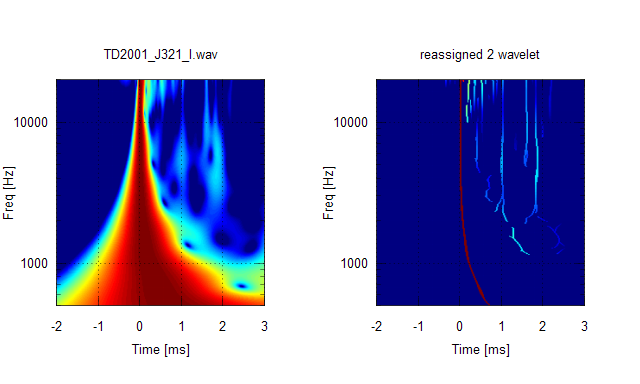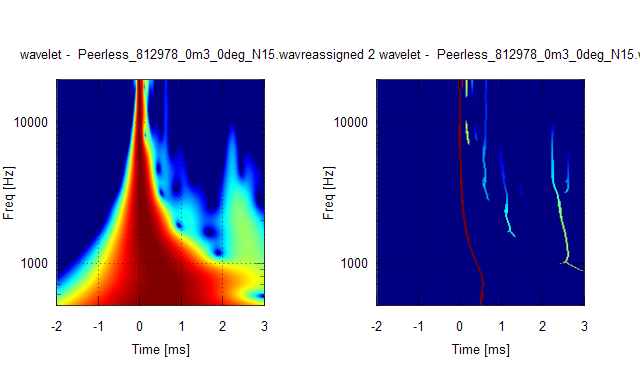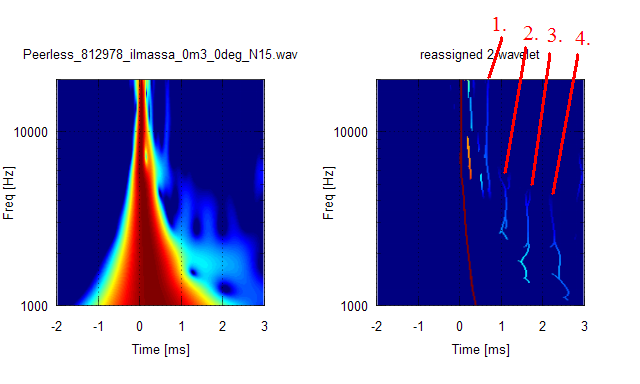Information in simple to find by googling it. It may not be suitable for pure audio amplifier purposes, but could be usefull for thermal runaway studies.
Some would argue that current-drive is actually preferred for pure audio purposes. I recently put together a pure current-feedback chipamp and I think sounds quite nice (with the right speakers). It doesn't use a Howland Current Pump. It is closer to Figure 1b from the Variable Impedance Amplifier link CLS posted. More details can be found here. I also haven't had any thermal runaway problems. Although, I am driving high sensitivity drivers so it just might not be a problem for me.
Roger
Sorry to interrupt the research ....
Just thought Gary and Lynn might like the attached pic of my first Jensen bass unit for the combination . I know it took me a barely finite amount of time to do this, but I'm quite proud of the woodwork !
I got some autoformers for the 288-H's from Dave a while back, and it was nice to find the horns sounded the same with or without the autoformers . Good effort Dave !
I'm off on hols to Austria now before tackling the final work on speaker no.2 ....
Mark
I would like to know more about that bass bin build. Im struggly to find a new great design for my bass bin and I really like that look. I have done sealed and simplistic ported designs. Im about to do a PR bass bin with AV15X/PRs from 25Hz to 200Hz but I would like another design option. I will PM you to keep this thread on track.
I think Nelson Pass has probably more extensive experience with current feedback as such.Some would argue that current-drive is actually preferred for pure audio purposes. I recently put together a pure current-feedback chipamp and I think sounds quite nice (with the right speakers). It doesn't use a Howland Current Pump. It is closer to Figure 1b from the Variable Impedance Amplifier link CLS posted. More details can be found here. I also haven't had any thermal runaway problems. Although, I am driving high sensitivity drivers so it just might not be a problem for me.
Roger
I think Nelson Pass has probably more extensive experience with current feedback as such.
Most definitely, but not with chipamps. Also worth pointing Nelson's wonderful creations still have some electrical damping which can be quite helpful. Since I'm a poor audio hacker building a chipamp made more sense (and cents) for me this go around.
Have you tried the "My Ref RevC" in the chip amp sector?Most definitely, but not with chipamps. Also worth pointing Nelson's wonderful creations still have some electrical damping which can be quite helpful. Since I'm a poor audio hacker building a chipamp made more sense (and cents) for me this go around.
Complete flair back
What do you think about fitting some pipe foam smoothly to the edge of the mouth of the Azura425 to continue the flair back into a full spiral as specified in the LeCleac'h expansion formula? It might reduce the ping pong reflections.
.
http://www.mcmaster.com/#foam-pipe-insulation/=8hr5qx
.
The link won't stay where I want it. Arrow ahead one page to 3484 and scroll down.
What do you think about fitting some pipe foam smoothly to the edge of the mouth of the Azura425 to continue the flair back into a full spiral as specified in the LeCleac'h expansion formula? It might reduce the ping pong reflections.
.
http://www.mcmaster.com/#foam-pipe-insulation/=8hr5qx
.
The link won't stay where I want it. Arrow ahead one page to 3484 and scroll down.
Last edited:
Hey Gary, any chance of seeing a polar graph on this current CD/Horn?
Dan
Perhaps eventually, but it's not going to be real soon, sorry!
I'm working on prototype crossovers now. Low pass filter for the TD15M is starting out as a 2nd order Bessel, -6 dB at 700 Hz, plus a notch filter centered at 1.8 kHz. High pass for the Radian 745 is starting out as a 3rd order Bessel. This weekend I am hoping to get them put together, make some measurements, and see if I can work toward a suitable result. I'll need to use resistive L-pads for level matching until the "Slagleformers" arrive.
I am giving Lynn the reins on the crossover development process, which we are working on offline. Stay tuned...
Gary Dahl
What do you think about fitting some pipe foam smoothly to the edge of the mouth of the Azura425 to continue the flair back into a full spiral as specified in the LeCleac'h expansion formula? It might reduce the ping pong reflections.
http://www.diyaudio.com/forums/multi-way/140190-jean-michel-lecleach-horns-17.html#post2278896
Michael
From what I have seen of the polars on the AH-425 (Augerpro's and my measurements with the GPA driver, and Bjorn's BEM simulations), I'm pretty comfortable with the 700 Hz crossover. The polar pattern is set by the horn, not the driver, so I don't feel like I am operating in the dark. Both the horn and woofer are at soft parts of their dispersion curve, so I don't think it's especially critical. Of course, I could be mistaken. I'm more concerned with trying to stay about an octave away from the AH-425's lower limit and the TD15M's issue at 1.5 kHz and above.
The horn mouth reflections are easily seen in the wavelet graph, and I wouldn't be surprised if it improved with the use of beach towels and/or pipe insulation, but there's going to be a reflection from the top of the TD15M cabinet anyway, even if I take steps to minimize its effect. I'm going to work with them in their current form and evaluate the results with my ears.
I do wonder about one thing, though. The wavelet ripples at 0.6 ms intervals correspond to distances of about 8 inches. The depth of the AH-425 on axis, without the driver, is 10 inches. The inside wall of the horn measures about 16" from the bugscreen to the edge of the mouth, so I'm not sure of the exact mechanism that is causing the 0.6 ms ripples.
Also, I was surprised at the comment about the AH-425 measuring "poorly" (on the referenced LeCleac'h horn thread). Can someone point out a horn/driver combination that measures better under similar conditions?
I don't like what I see above 10 kHz, of course, and am placing blame on the Radian. I don't know of any 1.4" driver that does better, though; any driver that size is in breakup mode by that time. And all of the other driver/horn combinations I have seen measurements of have a much lumpier response in the 700 - 10,000 range (let me know if I'm missing something). Lynn still believes that my G3 ribbons will be useful here, but if they don't work out, there are other drivers out there that are good at the top octave.
Gary Dahl
The horn mouth reflections are easily seen in the wavelet graph, and I wouldn't be surprised if it improved with the use of beach towels and/or pipe insulation, but there's going to be a reflection from the top of the TD15M cabinet anyway, even if I take steps to minimize its effect. I'm going to work with them in their current form and evaluate the results with my ears.
I do wonder about one thing, though. The wavelet ripples at 0.6 ms intervals correspond to distances of about 8 inches. The depth of the AH-425 on axis, without the driver, is 10 inches. The inside wall of the horn measures about 16" from the bugscreen to the edge of the mouth, so I'm not sure of the exact mechanism that is causing the 0.6 ms ripples.
Also, I was surprised at the comment about the AH-425 measuring "poorly" (on the referenced LeCleac'h horn thread). Can someone point out a horn/driver combination that measures better under similar conditions?
I don't like what I see above 10 kHz, of course, and am placing blame on the Radian. I don't know of any 1.4" driver that does better, though; any driver that size is in breakup mode by that time. And all of the other driver/horn combinations I have seen measurements of have a much lumpier response in the 700 - 10,000 range (let me know if I'm missing something). Lynn still believes that my G3 ribbons will be useful here, but if they don't work out, there are other drivers out there that are good at the top octave.
Gary Dahl
I know what you mean Gary, I just prefer to have my own measurements with the actual devices I'm going to use. I especially like to have good details on what's going on far off axis--something no one posts. Personally I wouldn't worry too much about the stuff over 10kHz.

If I didn't have a graph of that top octave issue, I wouldn't know there was one. YMMV, however it may not.
Dan

If I didn't have a graph of that top octave issue, I wouldn't know there was one. YMMV, however it may not.
Dan
Don't know. I believe the tweeter may be made by Vifa and the waveguides by EAW. The speaker is a Mackie HR624 mkII.

Mackie HRmk2 Applications
Dan

Mackie HRmk2 Applications
Dan
Also, I was surprised at the comment about the AH-425 measuring "poorly" (on the referenced LeCleac'h horn thread). Can someone point out a horn/driver combination that measures better under similar conditions?
Hello Gary
Depends of you design criteria. It's not a CD horn so in that respect there may be better but CD is not part of design criteria so it's a moot point. I wouldn't worry about. Get it up and running to hear what's going on. Over 10k
you are going to get some loss of detail put the overall upper octave balance shouldn't be that bad on axis.
Rob
I do wonder about one thing, though. The wavelet ripples at 0.6 ms intervals correspond to distances of about 8 inches. The depth of the AH-425 on axis, without the driver, is 10 inches. The inside wall of the horn measures about 16" from the bugscreen to the edge of the mouth, so I'm not sure of the exact mechanism that is causing the 0.6 ms ripples.
Gary Dahl
My guess: its possibly not from the horn.
Have you done those measurements with the horn hanging on a string from ceiling?
If not, maybe you repeat in such a setup to make sure no reflecting surfaces whatsoever are close by (you horn mount, the mid speaker cabinet ...)
Michael
Last edited:
Hi,
From the horn honk thread one of the best performers was Jean-Michel's J321 + TD2001

Compare this to my test with 20€ Peerless dome in a test baffle:

Baffle edge diffractions can be seen at about 0.6ms, 1ms and 2.5ms,
Consider also an attempt to remove baffle edge diffractions and hang the tweeter in free air by wires from the ceiling: And now there was diffractions from wave travelling around the tweeter itself.

One cannot escape diffraction with little effort only! It will allways be there with certain amount.
- Elias
From the horn honk thread one of the best performers was Jean-Michel's J321 + TD2001

Compare this to my test with 20€ Peerless dome in a test baffle:

Baffle edge diffractions can be seen at about 0.6ms, 1ms and 2.5ms,
Consider also an attempt to remove baffle edge diffractions and hang the tweeter in free air by wires from the ceiling: And now there was diffractions from wave travelling around the tweeter itself.

One cannot escape diffraction with little effort only! It will allways be there with certain amount.
- Elias
...
Also, I was surprised at the comment about the AH-425 measuring "poorly" (on the referenced LeCleac'h horn thread). Can someone point out a horn/driver combination that measures better under similar conditions?
I don't like what I see above 10 kHz, of course, and am placing blame on the Radian. I don't know of any 1.4" driver that does better, though; any driver that size is in breakup mode by that time. And all of the other driver/horn combinations I have seen measurements of have a much lumpier response in the 700 - 10,000 range (let me know if I'm missing something).
...
Also, I was surprised at the comment about the AH-425 measuring "poorly" (on the referenced LeCleac'h horn thread). Can someone point out a horn/driver combination that measures better under similar conditions?
FWIW, Paul W. built a pretty good MTM speaker that had rave reviews during a DIY event in Atlanta.
It uses the 18sound wavguide (XT1464)/1.4 CD (ND1460A). I think its breakup was up past 14KHz.
The measurements are here.
HTGuide Forum - View Single Post - The Raptor ... a 10" MTM
Last edited:
45 deg tangent point before the lip is how far from the horn throat on axis?...
I do wonder about one thing, though. The wavelet ripples at 0.6 ms intervals correspond to distances of about 8 inches. The depth of the AH-425 on axis, without the driver, is 10 inches. The inside wall of the horn measures about 16" from the bugscreen to the edge of the mouth, so I'm not sure of the exact mechanism that is causing the 0.6 ms ripples.
...
Gary Dahl
FWIW, Paul W. built a pretty good MTM speaker that had rave reviews during a DIY event in Atlanta.
It uses the 18sound wavguide (XT1464)/1.4 CD (ND1460A). I think its breakup was up past 14KHz.
Those measurements look great. I remember looking at that driver, but the manufacturer's curve didn't look nearly so good. Is that an unequalized measurement?
If so, and if it is compatible with the AH-425, it would definitely be worth a try!
Gary Dahl
- Home
- Loudspeakers
- Multi-Way
- Beyond the Ariel